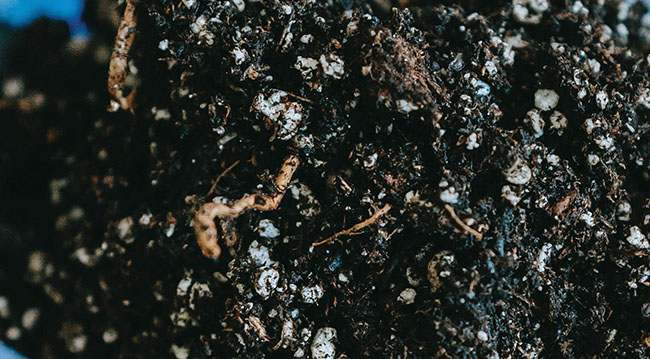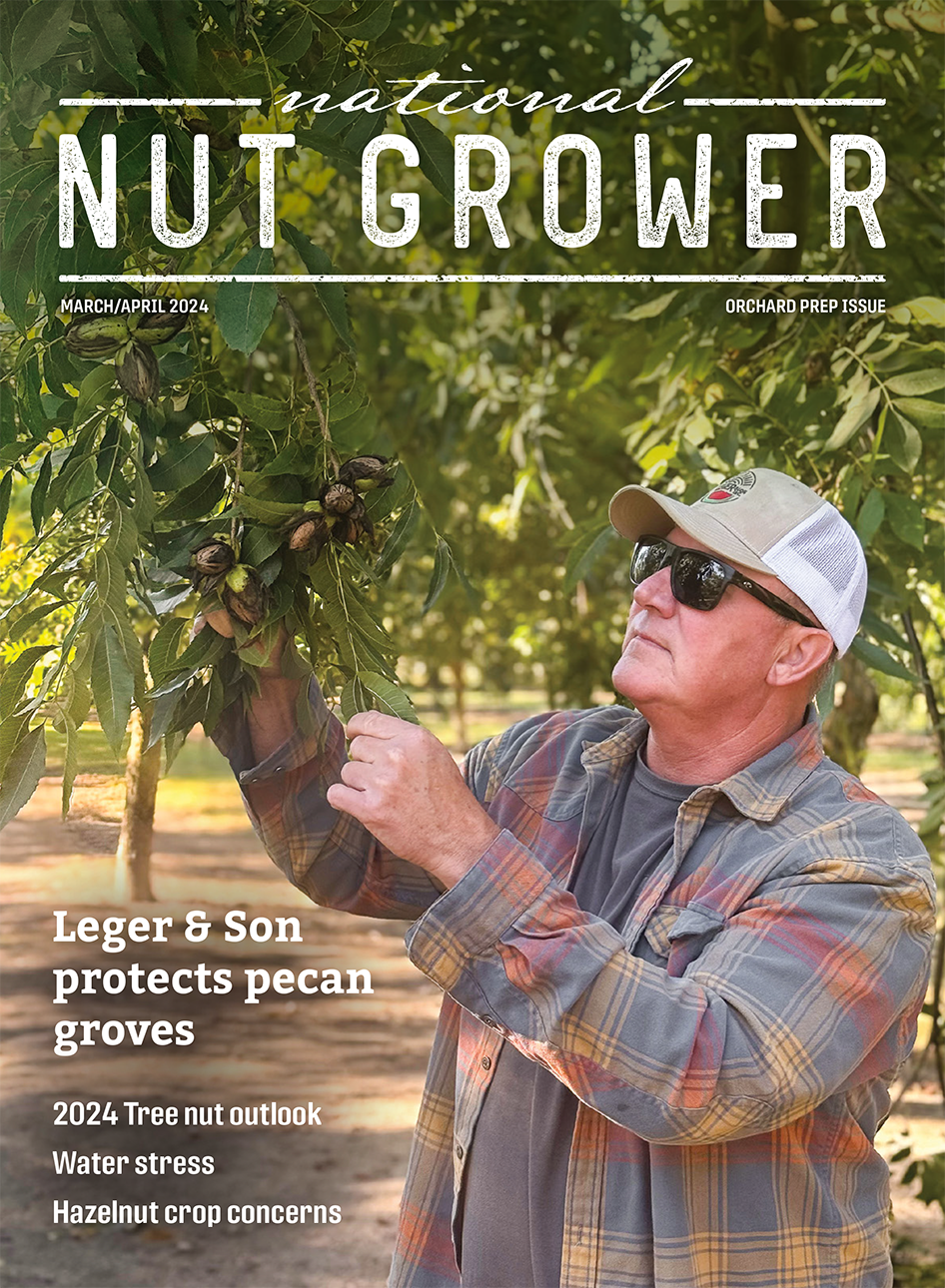
Nov/Dec 2022
Feeding microbes
While all things agriculture are only possible with water, there are few farmers who have never cursed water at its extremes.
West Coast and Southwest tree nut farmers manage widespread, year-after-year drought conditions. Southern pecan farmers are forced to wait for the rain to stop and hope flooding doesn’t cause too much damage. In both scenarios, the worst thing a grower can do is be unprepared.
Soil health (the biological integrity of the soil) and soil quality (how well soil does its job) both play a part in water holding capacity. Growers should support the physical, biological and chemical properties of soil to improve irrigation water productivity, water storage and crop productivity. When California almond growers adopted soil health management practices, nut yields increased 10% to 20%.
Whether your orchard is prone to flooding or droughts, growers can activate soil microbes to improve water holding capacity and reduce extreme weather damage and abiotic stressors.
Formulating the ideal soil for water holding capacity
The healthier the soil, the more water it can retain in drought — and the more water it can move through the soil profile if there’s excess. Here are some things to consider when determining soil health and quality.
Texture: Depending on the type of nut trees and the environmental impacts, soil texture should include a composition of sand, silt and clay.
Structure: Healthy soils have soil particles arranged into aggregates, which are essential for water and nutrient movement, penetration and retention.
Drainage and aeration: These both are essential to avoid nutrient loss and solubility. Poor drainage or soil lacking aeration can be at greater risk to flood damage.
Moisture: Essential for any orchard, moisture promotes nutrient uptake, root growth and overall tree well-being.
pH: Important to know and understand, as pH can change nutrient forms and affect nutrient availability.
Temperature: Soil temperature can affect nutrient uptake and an orchard’s ability to grow.
Soil microbes: These microorganisms promote healthy soil texture, structure, drainage, moisture retention, soil temperatures and nutrient availability. Soil microbes should be abundant, diverse, active and well-fed for you to reap these benefits.
By understanding the chemical, physical and biological makeup of your soil, you can support your orchard’s overall health and well-being.
What are soil microbes?
Soil microbes are microorganisms in the soil. One tablespoon of soil can have 50 billion soil microbes! They improve soil structure, texture and plant nutrient availability — but only if they’re active. As a survival mechanism, soil microbes will go dormant due to starvation or lack of water. Roughly 75% of farm soil microbes are dormant.
To wake them up and receive the benefits of active soil microbes in the orchard, they must be fed a carbon-rich microbial food. Root exudates can be a food source for soil microbes from June to August, but this is normally not enough. Some types of soil microbial food include microalgae, molasses and compost. Tree nut farmers should look for a soil microbial food that’s easy to add to their current applications.
Once active, soil microbes help mitigate abiotic stress. From water management to stress management, supporting bacteria and fungi soil microbes is crucial.
Drought-prone orchards
Many growers have the challenge of keeping moisture levels adequate year after year. Investing in an innovative soil microbial food can wake up soil microbes and improve water holding capacity to support trees during times of drought.
In warm, dry climates, soil microbes are able to create larger soil aggregates with microbial glues and nets. They increase soil moisture infiltration and the capacity for moisture storage. They improve an orchard’s resistance to drought stress and increase water productivity.
With increased penetration and infiltration, soil microbes help healthy soil transport water from the soil surface to down around the root zone and store the water in the soil. Farms with healthy soil lose less water in runoff, and soil moisture reserves from winter can contribute to the growing season’s evapotranspiration and lessen irrigation needs. Thus, feeding soil microbes makes the most of water year-round.
This is important because water intake affects nutrient intake. Water is the main channel roots use to intake nutrients and nutrient mobility. Water productivity makes nutrients more mobile, meaning nutrients can move through well-structured soil to where they’re needed. Drought conditions not only mean less water, but also less nitrogen and phosphorus intake, yielding a worse ROI on already expensive fertilizer.
Soil microbes also release a substance into the soil near the tree’s roots that can help manage abiotic stress. Osmoprotectants manage challenges by aiding in water balance under drought conditions. Antioxidants mitigate oxidative stress and internal plant cell damage during drought stress. Support at the roots can lead to healthier trees above ground and increase yield potentials for farmers, despite extreme drought conditions.

Flood-prone orchards
Flooding is the epitome of too much of a good thing. When water pools at the surface of an orchard, it can lead to erosion, nutrient loss and carbon loss. Other negative impacts include salt buildup, denitrification, leaching, soil compaction and loss of trees.
It often takes pecan trees as long to recover as they are flooded. Photosynthesis is reduced after five days of flooding. After 35 days, pecan trees may lose 30% of the root soil and are at risk of falling over. Pecan trees can handle some flooding, but not continuous flooding, and they can only stand to be waterlogged in well-draining soils. Continually wet soil with low oxygen levels can reduce vigor or cause dieback or tree death.
Too much water also means the tree has less access to essential oxygen. Oxygen (O2) is as essential to nut trees as water. Too little oxygen decreases water and nutrient uptake and affects kernel development. O2 plays a role in tree mineral and water absorption, manufacturing plant hormones, excluding sodium and other potentially toxic ions, breaking down sugars and producing needed root energy. Soil oxygen levels of 8-10% are considered the minimum threshold for supporting root health.
Soil microbes optimize cool and wet field conditions by creating larger soil aggregates and microbial glues and nets to hold and move water. They improve soil drainage, aeration of soil, resistance to water logging, and reduce runoff events.
Additional ways to support soil microbes
Utilize a cover crop. Living roots provide a source of food from the carbon released at the roots (exudates). Cover crops also reduce wind and water erosion and reverse the negative impact of soil compaction.
Incorporate mulch and compost into soils. These can act as an additional food source for soil microbes and will allow them to release nutrients for orchards at a slow release rate.
Reduce soil compaction. Soil density and aggregation play a role in determining water retention and water infiltration. Dense soil reduces aeration and microbial activity and can cause stunted plants and roots. Less dense soils allow roots to take up more water and soil, creating greater tree growth, yield, and water productivity.
Defend trees during drought or flood
Growers need to know the soil type, profile, drainage, season timing and tree physiological stage to support their orchards. But they don’t have to settle for the soil profile and drainage they already have and can make improvements. From Houston Black clay to Heidel sandy loam, soil microbes fed a well-balanced meal can improve your soil structure and texture to mitigate flood and drought damage.
If nutrient management and soil moisture are tightly bound to one another, soil microbes are a third strand to braid the three together.
Abundant, diverse and active microbes improve nutrient availability, nutrient uptake and nutrient transport. The support from soil microbes can give orchards a leg up on drought conditions, and unexpected flooding — but only if they’re awake.
While we can’t control the rain, we don’t always need to curse it either. Instead, spend time supporting soil microbes to improve water holding capacity to mitigate drought and flood damage.
It’s important for growers to learn about soil type and soil profile, as well as the total number, diversity and activity of soil microbes by working with a trusted advisor. Then, prepare for droughts or high water by incorporating a soil microbial food into the current application practice.







